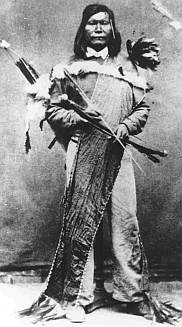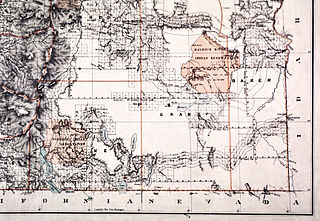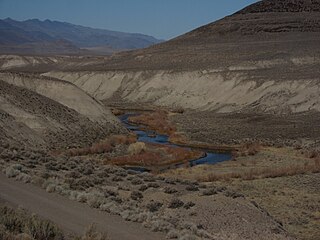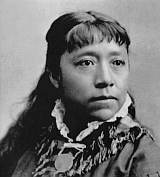
Truckee is an incorporated town in Nevada County, California, United States. As of the 2010 United States Census, the population was 16,180, reflecting an increase of 2,316 from the 13,864 counted in the 2000 Census and having the 316th highest population in California and 2114th in the United States.

Winnemucca is the only incorporated city in, and is the county seat of, Humboldt County, Nevada, United States. As of the 2020 census, the city had a total population of 8,431, up 14.0 percent from the 2010 census figure of 7,396. Interstate 80 passes through the city, where it meets U.S. Route 95.

Sarah Winnemucca Hopkins was a Northern Paiute writer, activist (lecturer) and educator. Her maiden name was Winnemucca.

Pyramid Lake is the geographic sink of the basin of the Truckee River, 40 mi (64 km) northeast of Reno, Nevada, United States.

The Northern Paiute people are a Numic tribe that has traditionally lived in the Great Basin region of the United States in what is now eastern California, western Nevada, and southeast Oregon. The Northern Paiutes' pre-contact lifestyle was well adapted to the harsh desert environment in which they lived. Each tribe or band occupied a specific territory, generally centered on a lake or wetland that supplied fish and waterfowl. Communal hunt drives, which often involved neighboring bands, would take rabbits and pronghorn from surrounding areas. Individuals and families appear to have moved freely among the bands.

Winnemucca Lake is a dry lake bed in northwest Nevada that features the oldest known petroglyphs in North America. Located astride the border between Washoe and Pershing counties, it was a shallow lake until the 1930s, but was dried when a dam and a road were built that combined to restrict and block water flow. It was formerly designated as a National Wildlife Refuge, but its status as a refuge was removed due to the lack of water.
According to reports of Northern Paiute oral history, the Si-Te-Cah, Saiduka or Sai'i were a legendary tribe who the Northern Paiutes fought a war with and eventually wiped out or drove away from the area, with the final battle having taken place at what is now known as Lovelock Cave near Lovelock, Nevada, United States. They had red hair, and are often described as having been cannibals. In some versions of the legend they were giants. In 1911, a large amount of artifacts and mummified human remains were discovered under three to six feet of guano by guano miners in Lovelock Cave.

The Paiute War, also known as the Pyramid Lake War, Washoe Indian War and the Pah Ute War, was an armed conflict between Northern Paiutes allied with the Shoshone and the Bannock against settlers from the United States, supported by military forces. It took place in May 1860 in the vicinity of Pyramid Lake in the Utah Territory, now in the northwest corner of present-day Nevada. The war was preceded by a series of increasingly violent incidents, culminating in two pitched battles in which 79 Whites and 25 Indigenous people were killed. Smaller raids and skirmishes continued until a cease-fire was agreed to in August 1860; there was no treaty.

Winnemucca was a Northern Paiute war chief. He was born a Shoshone around 1820 in what would later become the Oregon Territory.

The Malheur Indian Reservation was an American Indian reservation established for the Northern Paiute in eastern Oregon and northern Nevada from 1872 to 1879. The federal government discontinued the reservation after the Bannock War of 1878, under pressure from European-American settlers who wanted the land. This negative recommendation against continuing by its agent William V. Rinehart, led to the internment of more than 500 Paiute on the Yakama Indian Reservation, as well as the reluctance of the Bannock and Paiute to return to the lands after the war.

The Second Battle of Pyramid Lake took place in response to the U.S. defeat at the First Battle of Pyramid Lake. A well-organized force of militia and regulars, under the capable leadership of famed Texas Ranger Col. John C. "Jack" Hays, defeated the Paiute warriors under Chief Numaga. This was the final engagement of the Pyramid Lake War of 1860.
The First Battle of Pyramid Lake in 1860 was one of the opening conflicts of the Paiute War in Nevada between the American people and the Paiute people, who had resisted the increasing numbers of migrants who traveled the California Trail through their territory, taking scarce game and water resources, as well as altercations with the Pony Express.

The Winnemucca Indian Colony of Nevada is a federally recognized tribe of Western Shoshone and Northern Paiute Indians in northwestern Nevada.

William Matthew Ormsby was an early settler of Nevada who was instrumental in the establishment of Carson City and the Nevada Territory. Major Ormsby was killed leading a Militia force against Paiute Indians in what was called the Pyramid Lake War.

Numaga was a Paiute leader during the Paiute War of 1860 that centered on Pyramid Lake in what is now Nevada in the United States. The war was caused by an influx of miners and ranchers after silver was discovered in the Comstock Lode near to Carson City. The newcomers assaulted the Paiutes and destroyed their foods supplies. When the Paiutes responded, the U.S. Army used force to suppress them. Both before and after the war, Numaga was a strong advocate of peace and did much to reduce the violence on both sides. He died of tuberculosis, a "white man's disease", in 1871.

The Fort McDermitt Paiute and Shoshone Tribe is a federally recognized tribe of Northern Paiute and Western Shoshone peoples, whose reservation Fort McDermitt Paiute and Shoshone Tribes of the Fort McDermitt Indian Reservation spans the Nevada and Oregon border next to Idaho. The reservation has 16,354 acres (6,618 ha) in Nevada and 19,000 acres (7,700 ha) in Oregon.
The Battle of Mud Lake/Mud Lake Massacre, also known as the "Skirmish at Mud Lake", occurred on 14 March 1865 during the Snake War in northwest Nevada Territory, at present-day Winnemucca Lake, Nevada, during the closing months of the concurrent American Civil War.
Life Among the Paiutes: Their Wrongs and Claims is a book that was written by Sarah Winnemucca in 1883. It is both an autobiographic memoir and a history of the Paiute people during their first forty years of contact with European Americans. It is considered the "first known autobiography written by a Native American woman." Anthropologist Omer Stewart described it as "one of the first and one of the most enduring ethnohistorical books written by an American Indian," frequently cited by scholars. Winnemucca wrote Life Among the Paiutes: Their Wrongs and Claims while she was doing lectures on the East Coast of the United States, advocating in the English language for the rights of the Northern Paiute people, and she was assisted in the funding, editing, and publishing of the book by sisters Elizabeth Palmer Peabody and Mary Peabody Mann.

William Vance Rinehart was an American soldier who served as a Union Army officer in both the 1st Oregon Volunteer Cavalry Regiment and 1st Oregon Volunteer Infantry Regiment during the American Civil War. He was later appointed as Indian agent at the Malheur Indian Reservation in eastern Oregon. Rinehart then moved to Seattle, Washington where he engaged in business and was active in state and local politics. He was elected to Washington state's first legislature, serving as a state senator from 1889 through 1890.















